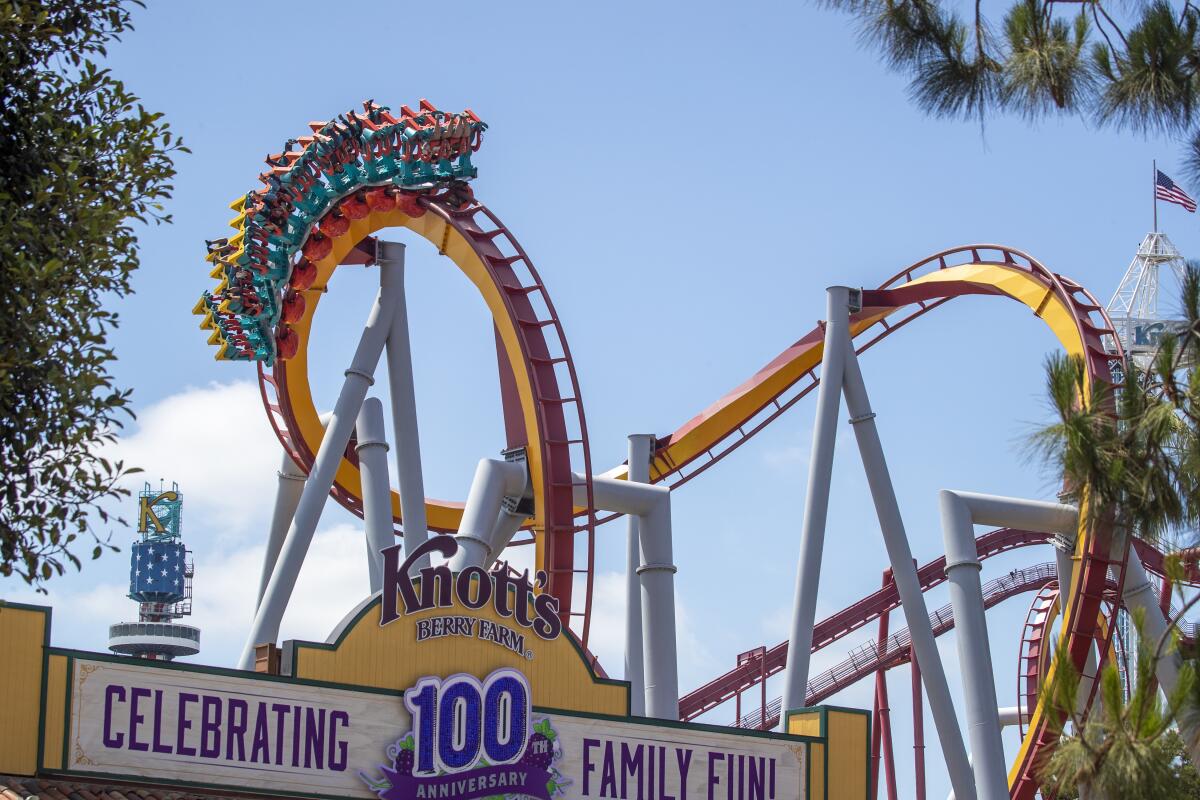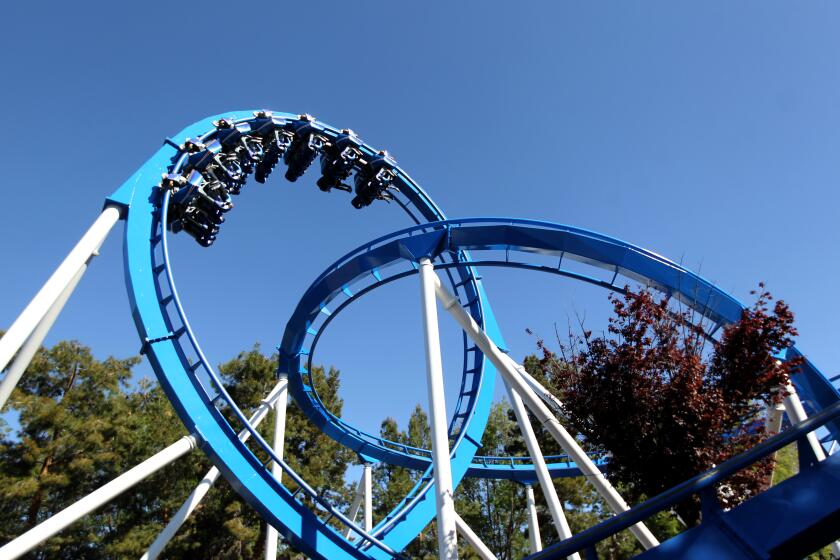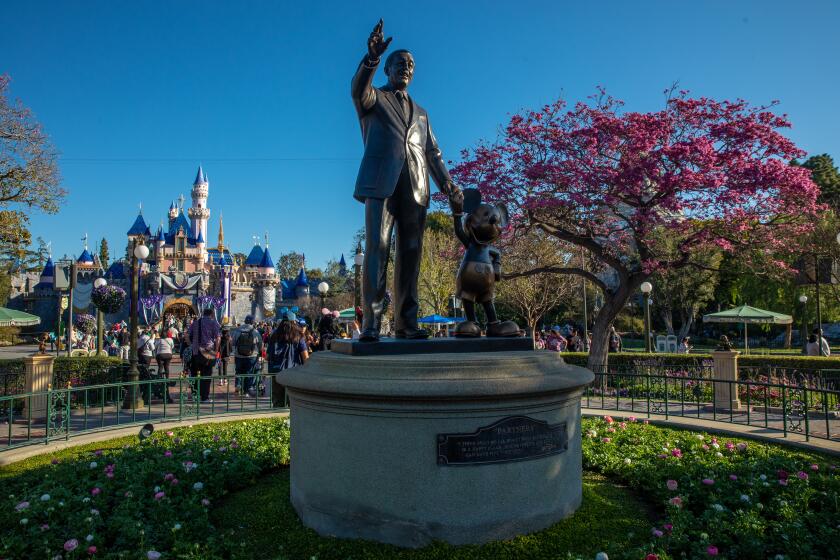Six Flags and Knott’s Berry Farm owners to merge, reshaping theme park landscape in mega-deal

Two iconic Southern California theme parks, Six Flags Magic Mountain and Knott’s Berry Farm, would come under the same ownership as part of a mega-merger announced Thursday that is set to reshape the industry.
The planned merger of Cedar Fair, the Ohio company that owns Knott’s Berry Farm in Buena Park, and Six Flags Entertainment Corp., the Texas owner of Magic Mountain in Valencia, is expected to increase the footprint and earnings for the blended amusement park corporation with more than 40 regional theme parks across North America.
However, many industry experts say they will be closely watching how the two Southland parks weather the union, as Magic Mountain and Knott’s Berry Farm are the only two parks in the merger operating long-term in the same market.
“The question is how strongly they plan to integrate,” said Martin Lewison, an associate professor of business management at Farmingdale State College in New York who teaches courses on theme parks. He said he didn’t expect that either of the two parks would close under the planned merger — if approved in early 2024 — especially if the two locations are able to preserve their distinctness: Magic Mountain is geared for thrill seekers, and Knott’s is more of a family destination.
“It makes sense to maintain a diverse identity,” Lewison said. “If it’s a cookie-cutter park, [Angelenos] are never going to make the drive.”
The only other parks that fall into the competition-turned-counterpart category are in the San Francisco Bay Area, home to Six Flags Discovery Kingdom and Cedar Fair’s Great America. But Lewison noted the latter is already set to close in the next few years, making it less of a concern.
In Southern California, there are ways for the merged company to leverage the joint ownership, primarily by emphasizing their different elements to entice visitors to both, said John Gerner, managing director of Leisure Business Advisors, a Richmond, Va., consulting firm.
“They don’t directly clash with each other,“ Gerner said. He compared the situation to a merger in Orlando, Fla., that brought Busch Gardens Tampa Bay under SeaWorld Parks & Entertainment but was able to keep SeaWorld and Busch Gardens successful, despite being close geographically.
“It worked well because they ended up doing a lot of cross-promotions and essentially made it easier to visit the other park,” Gerner said. The new merger’s “goal is going to try to make it seem as though you’ll want to take advantage of both of these parks.”
It’s not immediately clear what would change under the merger, as it still is pending regulatory and shareholder approval, but the deal would combine Cedar Fair and Six Flags leadership, while moving its headquarters to Charlotte, N.C., and using the Six Flags name, according to the company news release.
The merged company would include 27 amusement parks, 15 water parks and nine resort properties in 17 states, Canada and Mexico.
Santa Clara’s Great America amusement park will close in six to 11 years after being sold to Prologis, a real estate developer, for $310 million.
Consolidating two of the nation’s largest amusement park companies would increase the combined company’s earnings by an estimated $200 million over three years, through anticipated operational and administrative savings, as well as an increase in revenue, according to an announcement from the companies. The unified company would be worth an estimated $8 billion, according to both companies.
“They have new buying power with their supplies, and certainly they have more negotiating power with creditors,” Lewison said. He said having better access to capital is an advantage in the theme park industry because parks routinely build new upgrades and rides.
“With Six Flags, we will expand our footprint, enhance the resilience of our business model, and bolster our financial profile to drive in-park investments,” Richard Zimmerman, chief executive of Cedar Fair, said in a statement. “This transaction will allow us to build on our strategy to transform our park operations and deliver the most entertaining experiences to guests.”
Some theme park enthusiasts were more surprised than others by the merger, but Gerner said he sees the decision as part of the “natural progression” for theme parks since they first started developing in the 1950s, slowly becoming less independent.
Lewison said there had been recent concern about Six Flags losing confidence among its passholders and investors, as it raised prices without adding attractions.
“There’s definitely a feeling that, at least in the current state of things, that Cedar Fair is better at managing theme parks,” Lewison said, which is why he said he was happy to see a shared leadership plan for the merger.
“The combination of Six Flags and Cedar Fair will redefine our guests’ amusement park experience as we combine the best of both companies,” Selim Bassoul, chief executive of Six Flags, said in a statement. “We are excited to unite the Cedar Fair and Six Flags teams to capitalize on the tremendous growth opportunities and operational efficiencies of our combined platform for the benefit of our guests, shareholders, employees and other stakeholders.”
Zimmerman would serve as CEO of the combined company, while Bassoul would serve as executive chairman of the combined company’s board of directors, company leaders said.
Knott’s Berry Farm will sell “no-boo” necklaces this year for patrons not looking to get frightened at the theme park’s annual after-hours horror event.
Six Flags operates Magic Mountain as part of its nationwide portfolio; Cedar Fair has owned and operated Knott’s Berry Farm in Buena Park since 1997. Both parks operate seasonal water parks: Hurricane Harbor at Magic Mountain, and Soak City at Knott’s Berry Farm.
The legal decision seems to mean Disneyland will have to boost the wages of many resort workers. The legal battle has been brewing since 2018.
The unified company plans to offer what it described as “expanded park access” to passholders as well as an “enhanced, combined loyalty program.”
These regional parks offer a different experience from what Gerner called “destination parks” such as Disneyland and Universal Studios Hollywood. He doesn’t expect the merger to greatly affect how these parks compete with those powerhouses.
“These parks have always been in the shadow of Disneyland from the start,” Gerner said. “In many ways, these parks have learned that they depend on an appeal that’s different than Disney and Universal.”
Disneyland in Anaheim had almost 17 million visitors in 2022, the second-most-visited park in the U.S., based on 2022 attendance, behind only Magic Kingdom in Orlando, according to an estimate by the Themed Entertainment Assn.’s 2022 Theme Index report. Knott’s Berry Farm came in among the top 20, with 3 million visits, just ahead of Magic Mountain, with 2.9 million.
“Disney spends $250 million on a new ride,” Lewison said. “They’re on a different level in terms of scope and scale.”
He said Magic Mountain and Knott’s are able to hit more of a “middle market” for leisure spenders, while Disney offers a much more expensive experience — which is what the new merger needs to continue to emphasize.
“There’s opportunity for parks that don’t cost you an arm or a leg to bring the family,” Lewison said.
More to Read
Sign up for Essential California
The most important California stories and recommendations in your inbox every morning.
You may occasionally receive promotional content from the Los Angeles Times.













